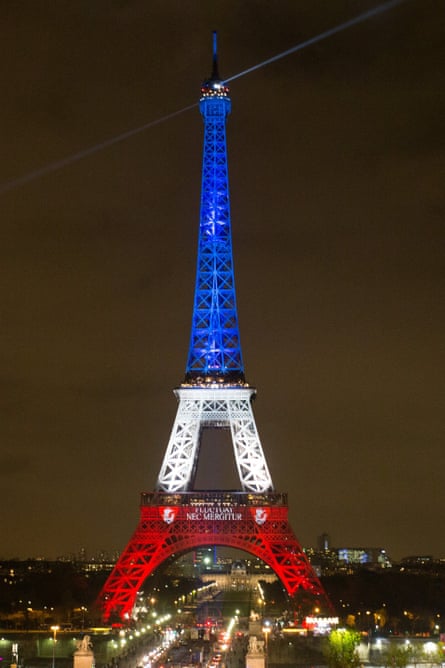Nothing says Paris like the Tour Eiffel. And, increasingly, France’s most recognisable attraction is being used to speak to the world.
After the 13 November attacks, when terrorists killed 130 people, the city’s motto in Latin: Fluctuat nec mergitur (She is tossed by waves but does not sink) was projected on the celebrated Dame de Fer. For the following three days, as the mayor, Anne Hidalgo defiantly declared that despite its grief “Paris is still standing”, the tower was lit in the colours of the tricolour: red, white and blue. An image of the tower in the form of the international peace symbol quickly caught on in social media among those wishing to show solidarity with the bruised but unbeaten city.
By the time the COP21 climate summit was opening on 30 November, the tower had gone an appropriate shade of green.

The Eiffel Tower peace symbol was designed by Jean Jullien, 32, a French illustrator living in London. “When I heard the news the first thing that came to mind was to draw a symbol of peace and solidarity for Paris. It was an immediate reaction, as a person rather than a professional. I drew this to show I was thinking about people in Paris,” Jullien told journalists afterwards.
“All I wanted was a strong symbol, something all the world could easily understand, and that all the world could share no matter where they were from … I wanted something universal.”
Gustave Eiffel’s 300-metre iron tower has always carried a message. It was constructed as the French national centrepiece for the 1889 Universal exhibition as a monument to industrial and cultural might. Having escaped demolition when the exhibition closed, as was planned, it remained the world’s tallest building for more than four decades.

The original lighting was basic and delicately illuminated the tower’s outline. In 1925, on the eve of the International exhibition of Modern Industrial and Decorative Arts, the tower was lit up by the name Citroën in 30-metre high letters, turning the tower into what the Guinness Book of Records called the world’s largest advertisement. André Citroën had hired the tower to promote his company using 250,000 lights. The sign remained in place until the motor company went bankrupt in 1934 and was saved by Michelin.
In 2000 a revolving beacon fitted with 6,000W lamps was installed to mark the turn of the century, and last September the tower was lit in the colours of South Korea as part of a year of cultural events. It has also sported the colours of other national flags, including Italy, Turkey and Mexico, to mark state visits or joint cultural events.
In 2004 it went entirely red to mark the Chinese new year and, two years later, turned blue for the 20th Fête de l’Europe. In 2007, for the Rugby World Cup, half the tower turned green to evoke a rugby pitch, and lights in the form of a goal were installed. Last year, the global fight against breast cancer saw the tower turn pink.
Since the Charlie Hebdo attack in January this year, Parisians have found comfort in national symbols: the Marianne statue at the centre of Place de la République has become, like the square itself, a shrine to the memory of those who died.

Comments (…)
Sign in or create your Guardian account to join the discussion